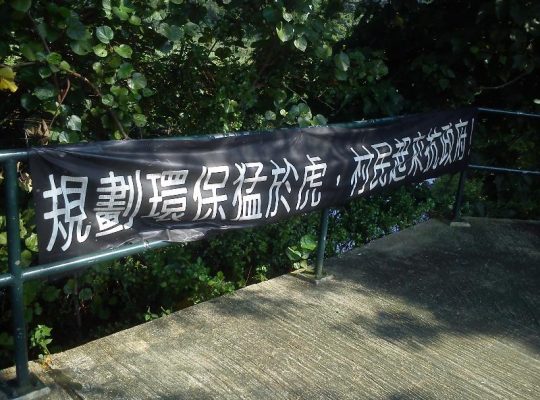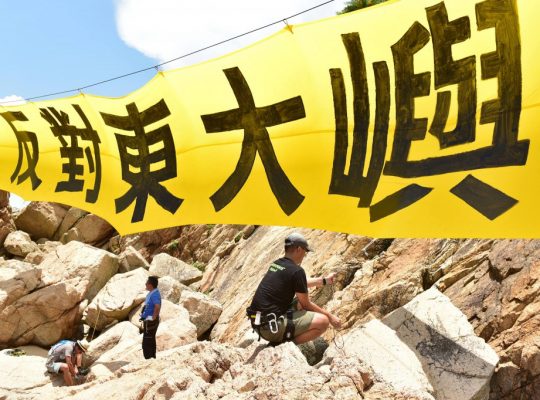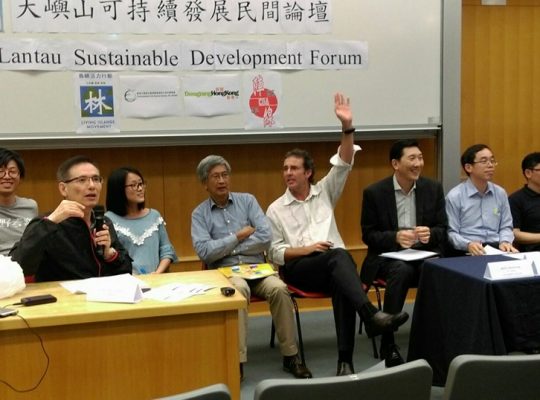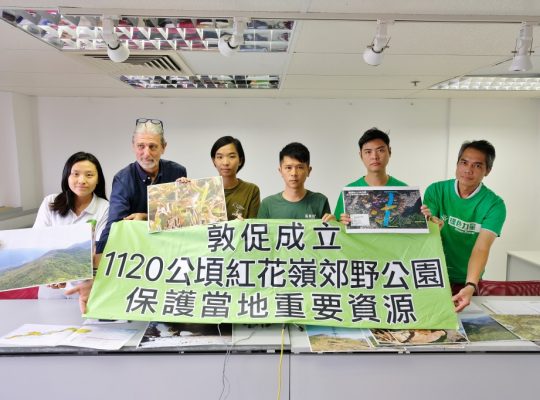Click here for the English version
土地共享先導計劃
關於南生圍及社山兩宗申請的聯合聲明
1. 就最近兩宗在土地共享先導計劃(LSPS)下分別位於南生圍(LSPS-002 )及林村社山(LSPS-003 )的申請,我們希望藉此聯合聲明表達深切關注。該兩個申請地點現在主要為鄉郊環境所覆蓋及包圍,發展密度極低;而有關申請不但會為該兩處引入高樓大廈(LSPS-002:24至25層;LSPS-003:17至39層),更會帶來龐大人口(LSPS-002:10,487人;LSPS-003:33,937人)。簡而言之,我們認為這兩個項目實在難以理解,我們會在下文詳細闡述。
生態環境問題
2. LSPS-002的申請地點位處南生圍核心濕地的南面,而該地點本身也有魚塘及河道。事實上,此地點亦位於濕地緩衝區(WBA)內;顧名思義,WBA本來就是要為緩衝敏感及具國際重要性的后海灣濕地而設 。WBA亦為繁殖期的鷺鳥提供飛行通道,以進入濕地保育區(WCA)內的覓食地。我們因此非常關注擬議的高樓會影響WBA原應發揮的緩衝作用及繁殖鷺鳥。南生圍核心濕地及周邊河道是不少具高保育重要性的水鳥的生境(包括全球性受威脅的黑臉琵鷺 Platalea minor)。區內亦有一個具區域重要性的普通鸕鷀(Phalacrocorax carbo)冬季棲地。此外,這區亦為在內地及香港都極具保育關注的歐亞水獺(Lutra lutra)提供生境。上述動物基本上對人類活動都極度敏感。擬議的9棟住宅高達24至25層,不但明顯阻礙雀鳥飛行路線,也會產生各種如光害及噪音的影響,干擾四周相對低矮的環境。擬議發展所帶來的人口亦會令區內的人類干擾大增,影響上述生態敏感受體。
3. 社山的擬議發展(LSPS-003)估計可能會令整個林村谷的人口激增約1.75倍(2016年的中期人口統計顯示林村谷只有19,369人 )。現時,該區的建築主要為三層高的村屋。明顯地此項涉及樓高17至39層共28棟大廈 (未包非住用建築)的發展建議,必然會嚴重破壞區內景觀及影響生態。擬議發展地點及其周邊現存大量農地及河道,為不少依賴開闊原野的具保育價值鳥種提供覓食及棲息地,包括全球性極危的黃胸鵐(Emberiza aureola)及易危的硫磺鵐(Emberiza sulphurate)。此外,擬議發展項目與覆蓋社山風水林的社山具特殊科學價值地點(SSSI)的最短距離少於10米,而此SSSI為不少具保育價值的動植物(如櫟子青岡(Cyclobalanopsis blakei)、褐林鴞(Strix leptogrammica)、黑冠鳽(Gorsachius melanolophus)提供生境。受法例保護的寬藥青藤(Illigera celebica)生長在社山風水林的邊陲,此稀有植物亦為稀有蝴蝶燕鳳蝶(Lamproptera curius)幼蟲的寄主。此外,最新的研究亦表明道路人工照明會對周邊環境的昆蟲數量構成重大影響 (而光害也能嚴重影響其他動物)。故此,觀乎社山擬議發展的位置,高度及規模,令人無法不聯想到此發展會大大干擾該區的野生生物(如昆蟲、在夜間活躍的雀鳥及蝙蝠)。
4. 我們相信這兩個項目更可能會大大增加路殺及鳥撞風險,直接影響野生生物和當區生物多樣性。
規劃問題
5. 如上述,LSPS-002的申請地點位於WBA內,此區的發展受到城市規劃委員會(城規會)規劃指引編號12C的規管。擬議項目地點覆蓋一些魚塘及河道,相關計劃摘要內的圖則顯示,一段河道及部份魚塘面積會因為該發展而消失。城規會規劃指引編號12C指出,在考慮后海灣地區的發展建議時,會採用「不會有濕地淨減少」的原則。儘管申請人近日在報章聲稱會遵循有關原則 ,LSPS-002現時唯一公開的正式文件(即計劃摘要)中,卻未有詳細說明該擬議發展會如何遵守這個原則。
6. LSPS-003的申請地點及林村谷均為林村分區計劃大綱核准圖 所覆蓋。而該圖則的整體規劃意向如下:
該區的發展是以「全港發展策略檢討」和「新界東北發展策略檢討」的結果作為指引的。這兩項檢討都沒有選定該區為可作策略性增長的地區。當局就新界東北的長遠發展所制訂的整體規劃政策,着重保育和保護鄉郊腹地的天然環境和景觀,而除現有新市鎭人口和已承諾進行的市區式發展帶來的人口外,會盡量遏止該區的人口增長。現在和已承諾建設的運輸和基礎設施網絡,不足以承受該區截至二零一一年的額外人口增長。
鑑於新界東北的發展受到限制,以及有需要保育/保存該區的鄉郊特色、天然景觀和生態價值,當局不鼓勵在區內闢設露天貯物場或進行非正式的工業和住宅發展。因此,該區的規劃意向,一方面是透過管制區內的發展和促進農業活動,以保存其鄉郊特色;另一方面是在適合發展的地點容許鄉村擴展……
7. 綜觀上述內容及社山擬議項目的發展參數,我們認為有關計劃根本不符合林村谷的原規劃意向。
公眾參與及透明度問題
8. 關於LSPS的公眾參與及透明度問題,我們在相關文件看到下列敘述:
立法會參考資料摘要(土地共享先導計劃) (DEVB(PL-CR)1-55/127/1) :
……為建立信心及保障公眾利益,先導計劃會採用具透明度的機制,並由特 設的顧問小組提供第三方意見。所有相關法定程序,包括修訂法定圖則及授權進行公共道路/渠務工程等刊憲程序,以至現有這些法定程序所涉及的公眾參與渠道,將繼續適用……
……自二零一九年《施政報告》公布後,發展局就先導計劃的擬議框架諮詢了主要持份者,包括立法會發展事務委員會(事務委員會)、香港地產建設商會(地產商會)、土地及建設諮詢委員會、與發展相關的專業學會、鄉議局等。事務委員會亦於二零二零年一月召開會議聽取代表團體的意見。經考慮接獲的意見及政策目的,發展局建議,行政長官會同行政會議批准以下詳列的先導計劃細節,以予實施……
立法會發展事務委員會討論文件(LC Paper No. CB(1)160/19-20(03)) :
……為保持透明度,先導計劃的資料、接獲的申請及每宗申請的進度均會於不同階段向公眾發布。我們會公布接獲的申請細節,亦會在顧問小組就個別個案討論後公布小組的意見。現行法定規劃、環境、收地及/或工程授權程序下的既定公眾參與渠道將繼續適用……
9. 我們同意建立信心、保障公眾利益及保持透明度為LSPS的重要構成部分。可是,目前我們只能從計劃摘要得悉極少有關項目的資料,相關計劃摘要亦無附上任何有關項目潛在影響的評估。沒有進一步資料,公眾如何能適切地對這些位處於環境敏感地區的發展項目提供意見?
「先破壞,後發展」問題
10. 社山的申請地點曾經被嚴重破壞(傾倒泥頭),而亦因為這個個案,有關方面修訂了分區計劃大綱圖內農業地帶的註釋,以處理農業地帶的填土問題及加強規劃管制 。
11. 城規會亦曾公布 :
城規會決心保護鄉郊及天然環境,不會容忍任何蓄意破壞鄉郊及天然環境的行動,企圖使城規會對有關土地上的其後發展給予從寬考慮……
12. 我們希望各有關方面仔細考慮在此地點擬議發展任何大型項目是否恰當。
結論
13. LSPS有一個「最少新增房屋數量」準則,原意是為儘量增加每個申請的總樓面面積8。雖然這個試驗性策略或能在一些地方增加房屋供應,我們認為在某些錯誤地點以非常高聳及高密度的發展去達至LSPS的準則本身就是一個錯誤。LSPS的目的是協調發展過程,而非漠視政府一貫的發展措守及規範,對現有社群及敏感的生物多樣性,仍須一如既往地緊慎考量及妥善兼顧。
14. 現時有關這兩個項目的資訊非常少,直接影響討論的成效及事實基礎。儘管如此,憑我們現時手上的資料,我們認為南生圍及社山這兩處絕不適合發展如此「非常」的大型項目。由於現時的公開資料沒有包含任何詳細評估報告,我們不清楚擬議項目明顯會引致的潛在影響如何能夠得到處理。
15. 我們絕對明白弱勢社群對公營房屋的需求,但確實亦難以理解在偏遠鄉郊建屋能如何切合基層所需–上述兩個申請地點不但缺乏公共運輸系統等適切的基礎建設,更為敏感環境所包圍。我們亦要問,這些項目能如何維護無價的天然資源予後代共享?我們重申並強調,社會上眾多界別早已指出,香港仍有很多適合作公營房屋發展的土地資源,也有不少增加房屋供應的方法。
16. 綜觀以上資訊,及為了確保下一代的環境不會受到不可逆轉的破壞,我們不支持這兩個項目。
聯署團體(依筆劃序):
世界自然基金會香港分會
長春社
香港鄉郊基金
香港觀鳥會
創建香港
綠色力量
嘉道理農場暨植物園
Joint Statement from NGOs concerning Two Applications under the Land Sharing Pilot Scheme at Nam Sang Wai and She Shan
1. We would like to express our grave concern regarding two recent applications submitted under the Land Sharing Pilot Scheme (LSPS), one at Nam Sang Wai (LSPS-002) and the other at She Shan, Lam Tsuen (LSPS-003). At present, the two application sites and their surroundings are highly rural in nature with significantly low development density. The proposed developments, however, would introduce many high-rise blocks (LSPS-002: 24 to 25 storeys; LSPS-003: 17 to 39 storeys) and large populations (LSPS-002: 10,487; LSPS-003: 33,937) into these two places. Simply speaking, from various perspectives, we have found these two proposals to be completely incomprehensible; our detailed views are presented below.
Ecological issues
2. The application site of LSPS-002 is located to the south of the core wetland area of Nam Sang Wai, and the site itself also encompasses several fish ponds and a watercourse. Indeed, the site is well within the Wetland Buffer Area (WBA) which is primarily delineated to buffer the sensitive and internationally important Deep Bay wetlands. More importantly, WBA also serves as a flight path/corridor for breeding ardeids to access their foraging grounds within the Wetland Conservation Area (WCA). We are highly concerned that the proposed high-rise blocks would undermine the buffering function which the area is designated to provide, and would have adverse impacts on the breeding ardeids. The core Nam Sang Wai area as well as the channels surrounding the application site are habitats for many waterbird species of high conservation importance, including the globally threatened Black-faced Spoonbill (Platalea minor). It is also a winter roosting site for Great Cormorant (Phalacrocorax carbo), and is of regional importance. The area also provides habitats for the Eurasian Otter (Lutra lutra), which is of very high conservation concern in Hong Kong and mainland China. These species are in general highly sensitive to human activities. The proposed 9 high-rise blocks ranging from 24 to 25 storeys would become an obvious obstacle to bird flightpaths and impose various impacts such as light and noise disturbance on the relatively low-rise surroundings. The proposed increased population would also greatly increase human disturbance to the above mentioned ecological sensitive receivers in the region.
3. The proposed development at She Shan (LSPS-003) would greatly increase the population of Lam Tsuen Valley by a predicted 1.75 times (population of Lam Tsuen Valley is around 19,369 persons based on 2016 by-census). At present, there are mainly 3-storey village houses in this area. The proposed development, with 28 high-rise blocks (17 to 39 storeys each; not including those for non-residential uses), would completely destroy the landscape and also severely impact the ecology of the area. Within the application site and its surroundings, active and fallow farmlands as well as watercourses can be found; these habitats provide foraging and roosting grounds for various open country bird species of conservation importance (including globally Critically Endangered Yellow-breasted Bunting (Emberiza aureola), Vulnerable Japanese Yellow Bunting (Emberiza sulphurate)). Furthermore, the existing She Shan Site of Special Scientific Interest (SSSI), which is located less than 10 m from the proposed development boundary and largely covers the She Shan fung shui woodland (FSW), also provides habitats for many plants and fauna of conservation interest (e.g., Blake’s Oak (Cyclobalanopsis blakei), Brown Wood Owl (Strix leptogrammica), Malayan Night Heron (Gorsachius melanolophus)). The legally protected Illigera (Illigera celebica), which is a larval food plant for the rare butterfly – White Dragontail (Lamproptera curius), also inhabits the periphery of this FSW. A recent study has already indicated that street lighting would impose significant impacts on local insect populations (it has also been clearly demonstrated that street lighting can have serious impacts on other animal groups also). Thus it is not unreasonable to expect that the proposed development, in view of its scale, height and location, would greatly disturb local wildlife populations (e.g., insects, nocturnal birds, and bats).
4. We believe that both LSPS-002 and LSPS-003 would also significantly increase the wildlife road-kill occurrence and bird collisions in the areas of concern, thus imposing another direct impact on wildlife and the local biodiversity.
Planning issues
5. As aforementioned, the application site of LSPS-002 is within WBA, and development in this area is governed by the Town Planning Board (TPB) guidelines no. 12c3. The proposed development would cover some ponds and a watercourse. As shown in the plans attached to the application gist1, it seems that a section of the watercourse and also some pond areas would be lost. According to the TPB guidelines no. 12c, there is a ‘no-net-loss in wetlands’ principle in considering development proposals for the Deep Bay Area. Although the applicant claimed in a recent newspaper article that this principle will be followed, we cannot see, at present, from the only available official document of LSPS-002 (i.e., the gist) how the principle can be adequately upheld under the current development proposal.
6. The application site of LSPS-003 and Lam Tsuen Valley are covered under the Approved Lam Tsuen Outline Zoning Plan (OZP). The general planning intention section of this OZP states the following:
Development within the Area is guided by the Territorial Development Strategy Review (TDSR) and the North East New Territories Development Strategy Review (NENT DSR). According to the TDSR and the NENT DSR, the Area is not identified for strategic growth development. The general planning policies for the long-term development in NENT emphasize conservation and landscape protection of the rural hinterland with minimum population growth other than those accommodated in existing new towns and committed urban development. The existing and committed transport and infrastructural networks will not be capable of sustaining additional growth up to 2011.
In view of the development constraints in NENT and the need to conserve/preserve the rural character, the natural landscape and the ecological interest of the Area, it is intended not to encourage open storage uses, nor informal industrial development and residential development in the Area. The planning intention for the Area is, therefore, to retain the rural character of the Area by controlling development and promoting agricultural activities, and to allow village expansion in areas where development is considered appropriate……
7. Looking at the proposed development parameters at She Shan with reference to the above, we consider that the current proposal is simply contrary to the original planning intention of Lam Tsuen Valley.
Public engagement and transparency issues
8. Regarding the issue of public engagement and transparency of LSPS, we can see from various relevant documents the following:
Legislative Council Brief for LSPS(DEVB(PL-CR)1-55/127/1):
……LSPS strives to build confidence and safeguard public interest, with transparent mechanism involving third-party opinion offered by the Panel of Advisors to be set up specifically for LSPS. All relevant statutory procedures on town planning and road/sewerage works gazettal, as well as the existing public participation channels under these processes, would continue to apply……
……Development Bureau (DEVB) has since the 2019 PA engaged key stakeholders including the Legislative Council (LegCo) Panel on Development, the Real Estate Developers Association of Hong Kong (REDA), the Land and Development Advisory Committee (LDAC), development-related professional institutes, Heung Yee Kuk (HYK), etc. on the proposed framework. The LegCo Panel on Development also convened meeting to receive views from deputations in January 2020……
Legislative Council Panel on Development Discussion Paper (LC Paper No. CB(1)160/19-20(03)):
……To uphold transparency, information on LSPS, applications received and progress of each case would be released to the public at different stages. We would publish details of the applications upon receipt and opinions of the Panel of Advisors on individual cases after its deliberation. The existing public participation channels under various statutory procedures in the planning, environment, land resumption and/or works authorisation regimes, etc. would continue as applicable……
9. We agree that building confidence, safeguarding public interest and upholding transparency are all important components of LSPS as claimed. However, at present we could only find extremely limited information regarding the proposals (i.e., from the gists only) and could not find any detailed technical assessments relating to the potential impacts of the proposal. Without further information, how can the public comment appropriately on the proposals in such environmentally sensitive areas?
‘Destroy First, Build Later’ issue
10. Some may remember that a case was raised previously as the application site at She Shan was impacted by serious environmental destruction (i.e., land filling), and the ‘Notes for Agriculture (AGR) zone’ on Outline Zoning Plans were even revised as a result of this case to tackle the problem of filling on AGR-zoned land and to strengthen planning control.
11. The TPB has also announced that:
The Board is determined to conserve the rural and natural environment and will not tolerate any deliberate action to destroy the rural and natural environment in the hope that the Board would give sympathetic consideration to subsequent development on the site concerned……
12. We urge all relevant parties to thoroughly consider whether it is still appropriate to propose any large-scale development at the She Shan site.
Conclusion
13. Under the LSPS there is a criterion called ‘Minimum Housing Gain’; its ultimate aim is to boost the gross floor area of each application8. While this experimental approach may increase housing supply in some places, we consider that applications with extraordinary high rise and high density development parameters should never appear in totally unsuitable locations, which is an incorrect way to achieve the LSPS criteria. The LSPS is not designed to over-ride all previous Government measures and controls on development but to facilitate a process which still requires careful and fair consideration for the existing communities and sensitive biodiversity.
14. Although the very limited information now available regarding the captioned proposals makes fruitful or fact-based discussion very difficult, our conclusion, based on the information we have in hand, is that the captioned localities, Nam Sang Wai and She Shan, are definitely not suitable for developments of such ‘extraordinary’ scale. We also cannot comprehend how the clear potential impacts that would be caused by the proposed developments can be addressed, as detailed assessment reports are lacking from the available information.
15. While we fully understand the public housing need of the underprivileged community in Hong Kong, it is unclear how building houses in fairly remote, rural locations is helpful to the immediate needs, given that they are lacking of basic infrastructures (e.g., adequate public transportation system), and have sensitive surroundings. It is also uncertain how such development can help to sustain the invaluable natural resources for our future generations. We would like to reiterate and emphasise that there are still many suitable land resources for public housing development and many options to increase housing supply, which have already been repeatedly pointed out by various sectors in the society.
16. In view of the above and in order to ensure that the environment for future generations is not to be impacted irreversibly, we, the signatories below, wish to make it clear that we do not support the two captioned proposals.
Co-organised groups (in alphabetical order):
The Conservancy Association
Designing Hong Kong
Green Power
Hong Kong Bird Watching Society
The Hong Kong Countryside Foundation
Kadoorie Farm and Botanic Garden
World Wide Fund For Nature Hong Kong







